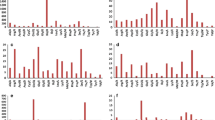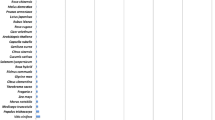Abstract
Genomic resources for peach, a model species for Rosaceae, are being developed to accelerate gene discovery in other Rosaceae species by comparative mapping. Simple sequence repeats (SSRs) are an important tool for comparative mapping because of their high polymorphism and transportability. To accelerate the development of SSR markers, we analyzed publicly available Rosaceae expressed sequence tags (ESTs) for SSRs. A total of 17,284 ESTs from almond, peach and rose were assembled into putatively non-redundant EST sets. For comparison, 179,099 ESTs from Arabidopsis were also used in the analysis. About 4% of the assembled ESTs contained SSRs in Rosaceae, which was higher than the 2.4% found in Arabidopsis. About half of the SSRs were found in the putative UTR, and the estimated average distance between SSRs in the UTR was 5.5 kb in rose, 5.1 kb in almond, 7 kb in peach and 13 kb in Arabidopsis. In the putative coding region, the estimated average distance was two to four times longer than in the UTR. Rosaceae ESTs containing SSRs were functionally annotated using the GenBank nr database and further classified using the gene ontology terms associated with the matching sequences in the SwissProt database. The detailed data including the sequences and annotation results are available from http://www.genome.clemson.edu/gdr/rosaceaessr/.




Similar content being viewed by others
References
Aranzana J, Pineda A, Cosson P, Dirlewanger E, Ascasibar J, Cipriani G, Ryder D, Testolin R, Abbott A, King J, Iezzoni F, Arus P (2003) A set of simple-sequence repeat (SSR) markers covering the Prunus genome. Theor Appl Genet 106:819–825
Brossard N (1997) FLIP: a Unix program used to find/translate orfs. bionet.software <Message-ID: 347B3A1B. 794BDF32@umontreal.ca>
Cardle L, Ramsay L, Milbourne D, Macaulay M, Marshall D, Waugh R (2000) Computational and experimental characterization of physically clustered simple sequence repeats in plants. Genetics 56:847–854
Cordeiro M, Casu R, McIntyre L, Manners M, Henry J (2001) Microsatellite markers from sugarcane (Saccharum spp.) ESTs cross transferable to erianthus and sorghum. Plant Sci 160:1115–1123
Dirlewanger E, Cosson P, Tavaud M, Aranzana J, Poizat C, Zanetto A, Arus P, Laigret F (2002) Development of microsatellite markers in peach [Prunus persica (L.) Batsch] and their use in genetic diversity analysis in peach and sweet cherry (Prunus avium L.). Theor Appl Genet 105:127–138
Georgi L, Wang Y, Yvergniaux D, Ormsbee T, Inigo M, Reighard G, Abbott A (2002) Construction of a BAC library and its application to the identification of simple sequence repeats in peach [Prunus persica (L.) Batsch]. Theor Appl Genet 105:1151–1158
Huang X, Madan A (1999) CAP3: a DNA sequence assembly program. Genome Research 9:868–877
Joobeur T, Viurel A, de Vicente C, Jauregui B. Ballester J, Dettori T, Verde I, Truco J, Messeguer R, Batlle I et al (1998) Construction of a saturated linkage map for Prunus using an almond × peach F2 progeny. Theor Appl Genet 97:1034–1041
Joobeur T, Periam N, de Vicente C, King J, Arus P (2000) Development of a second generation linkage map for almond using RAPD and SSR markers. Genome 43:649–655
Kantety V, Rota L, Matthews E, Sorrells E (2002) Data mining for simple sequence repeats in expressed sequence tags from barley, maize, rice sorghum and wheat. Plant Mol Biol 48:501–510
Levinson G, Gutman A (1987) Slipped-strand mispairing: a major mechanism for DNA sequence evolution. Mol Biol Evol 4:203–221
McCouch R, Teytelman L, Xu Y, Lobos B, Clare K, Walton M, Fu B, Maghirang R, Li Z, Xing Y et al (2002) Development and mapping of 2240 new SSR markers for rice (Oryza sativa L.). DNA Res 9:199–207
Miyao A, Zhong S, Monna L, Yano M, Yamamoto K, Havukkala I, Minobe Y, Sasaki T (1996) Characterization and genetic mapping of simple sequence repeats in the rice genome. DNA Res 3:233–238
Pearson D, Lipman J (1988) Improved tools for biological sequence comparison. Proc Natl Acad Sci USA 85:2444–2448
Pertea G, Huang X, Liang F, Antonescu V, Sultana R, Karamycheva S, Lee Y, White J, Cheung F, Parvizi B et al (2003) TIGR Gene Indices clustering tools (TGICL): a software system for fast clustering of large EST datasets. Bioinformatics 19:651–652
Reddy D, Abraham G, Nagaraju J (1999) Microsatellites in the silkworm, Bombyx mori: abundance, polymorphism, and strain characterization. Genome 42:1057–1065
Richard I, Sutherland R (1992) Dynamic mutations: a new class of mutations causing human disease. Cell 70:709–712
Sosinski B, Gannavarapu M, Hager D, Beck E, King J, Ryder D, Rajapakse S, Baird V, Ballard E, Abbott G (2000) Characterization of microsatellite markers in peach [Prunus persica (L.) Batsch]. Theor Appl Genet 101:421–428
Swinburne E, Turner A, Alexander J, Mickleson R, Binns M (2003) Characterization and linkage map assignments for 61 new horse microsatellite loci (AHT49–109). Anim Genet 34:65–68
Temnykh S, DeClerck G, Lukashova A, Lipovich L, Cartinhour S, McCouch S (2001). Computational and experimental analysis of microsatellites in rice (Oryza sativa L.): frequency, length variation, transposon associations, and genetic marker potential. Genome Res 11:1441–1452
Toth G, Gaspari Z, Jurka J (2000) Microsatellites in different eukaryotic genomes: survey and analysis. Genome Res 10:967–981
Waldbieser C, Bosworth G, Nonneman J, Wolters R (2001) A microsatellite-based genetic linkage map for channel catfish, Ictalurus punctatus. Genetics 158:727–734
Wang Y, Georgi L, Zhebentyayeva N, Reighard L, Scorza R, Abbott G (2002) High-throughput targeted SSR marker development in peach (Prunus persica). Genome 45:319–328
Webster M, Smith N, Ellegren H (2002) Microsatellite evolution inferred from human–chimpanzee genomic sequence alignments. Proc Natl Acad Sci USA 99:8748–8753
Whitfield W, Band R, Bonaldo F, Kumar G, Liu L, Pardinas R, Robertson M, Soares B, Robinson E (2002) Annotated expressed sequence tags and cDNA microarrays for studies of brain and behavior in the honey bee. Genome Res 12:555–566
Wierdl M, Dominska M, Petes D (1997) Microsatellite instability in yeast: dependence on the length of the microsatellite. Genetics 146:769–779
Wunsch A, Hormaza I (2002) Molecular characterization of sweet cherry genotypes using peach [Prunus persica (L.) Batch] SSR sequences. Heredity 89:56–63
Zhebentyayeva N, Reighard L, Gorina M, Abbott G (2003) Simple sequence repeat (SSR) analysis for assessment of genetic variability in apricot germplasm. Theor Appl Genet 106:435–444
Acknowledgements
This work was supported by an award (no. 0320544) from the National Science Foundation. Any opinions, findings and conclusions or recommendations expressed herein are those of the authors and do not necessarily reflect the views of the National Science Foundation.
Author information
Authors and Affiliations
Corresponding author
Rights and permissions
About this article
Cite this article
Jung, S., Abbott, A., Jesudurai, C. et al. Frequency, type, distribution and annotation of simple sequence repeats in Rosaceae ESTs. Funct Integr Genomics 5, 136–143 (2005). https://doi.org/10.1007/s10142-005-0139-0
Received:
Revised:
Accepted:
Published:
Issue Date:
DOI: https://doi.org/10.1007/s10142-005-0139-0




